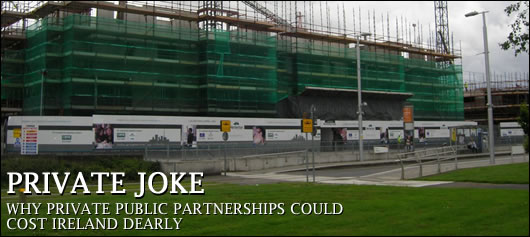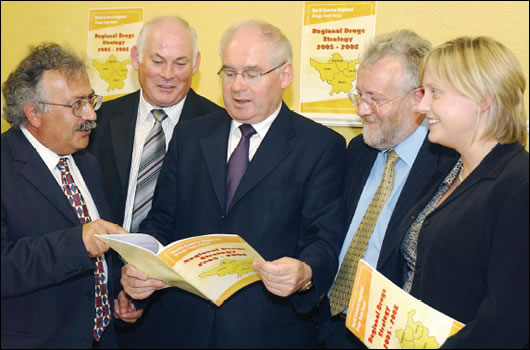- Policy
- Posted
Private joke

Public private partnership schemes have come to dominate many aspects of Irish infrastructural development, from toll roads to urban regeneration schemes. Jason Walsh asks if they amount to privatisation by stealth and whether they come at too high a social and environmental cost.
Widely hailed as saviours of public infrastructure, public private partnership (PPP) schemes have mushroomed across Ireland without much questioning of what they actually are and how effective they will be.
The term first entered into public consciousness during the late 1990s when the British new Labour government led by Tony Blair began to implement them, first as a means of providing infrastructure and later as a means of semi-privatisation of former state assets. Today across Britain and the North of Ireland there are hundreds of PPP schemes, including everything from hospital buildings to schools and quango headquarters, not to mention privatised schools run by businesses.
The Republic of Ireland has seen its fair share of PPP schemes also. Many major new roads have been built, and are operated by, private contractors and major redevelopment of Dublin housing estates such as St. Michael's in Inchicore and the Fatima Mansions in Rialto were carried out under such schemes.
In fact since adopting the PPP rhetoric, Ireland has become the third most enthusiastic nation in the world in their implementation, behind only Britain and Australia. Today in Ireland there are PPPs in transport, education, housing and urban regeneration. Indeed, there are over 100 PPP projects in the areas of waste and water alone.1
A recent report from Deloitte named 'Closing the Infrastructure Gap: The Role of Public-Private Partnerships' describes Ireland as one of the more advanced PPP markets and a model for other nations: "Countries at earlier stages of PPP development could benefit from the opportunity to learn from the trailblazers who have moved to more advanced stages: the United Kingdom for schools, hospitals and defence facilities; Australia and Ireland for roads sector also maintains the facility."2
This report from a partisan business, itself involved in administering public private partnerships here in Ireland, outlines a real problem and attempts to solve it by administering more private sector medicine:
"Citizens from New Delhi to New York confront the world's glaring infrastructure deficit daily. From country to country, the large and growing gap between infrastructure needs and the resources governments have historically invested in meeting those needs is obvious everywhere: congested roads; bridges in need of repair; poorly maintained transit systems and recreational facilities; and deteriorated hospitals, schools and waste treatment facilities all in urgent need of rehabilitation and repair. [...]
"In little more than a decade, a paradigm shift has occurred in how governments provide infrastructure. From Tokyo to Toronto, private sector financing, design, construction and operation of infrastructure has emerged as one of the most important models many governments use to close the infrastructure gap. Once rare and relegated to a handful of countries and infrastructure sectors, these public-private partnerships (PPPs) are delivering new and refurbished roads, bridges, tunnels, water systems, airports, schools, hospitals, social housing, and prisons. These PPPs involve long-term contractual relationships between government agencies and their private sector partners for the provision of an infrastructure asset or the delivery of a service."

Prominent PPP projects in Ireland the Laganside courthouse (left) and the old tower blocks at St Michaels, Inchicore (right) being demolished to make way for a new development
Deloitte, properly Deloitte Touche Tohmatsu, should know plenty about the Irish experience of PPP schemes, having profited from their introduction. From the Deloitte web site: "Since its introduction in Ireland, we have consistently been at the leading edge in the development and implementation of Public Private Partnerships (PPP). PPP brings the public and private sectors together in unfamiliar ways, and it is critical to bridging the gap of understanding if PPP is to work. Our strategy has always been to develop our PP[p] track record through working with public sector purchasers for PPP projects and with organisations active in the financing of PPP consortia."3
There are two important political aspects to the deployment of public private partnerships. The first is ideological in nature. PPPs offer, according to some, a backdoor to privatisation - public resources and infrastructure designed, built and often operated by profit-making concerns.
Secondly, and on a more practical level, public private partnership schemes allow the state to build infrastructure without capital expenditure - or at least without any explicit declaration of capital expenditure, after all, any building, bridge or road built is initially paid for by private investors. Clearly the financial aspect of PPPs is little understood. It is true that PPPs do not represent capital expenditure insofar as they are an 'off balance-book' expenditure. In reality this simply means that they are a hidden capital expenditure, not free money, and there is some question over how affordable the sum of the contracts will be ten or twenty years into their lives.
Moreover, few people realise that PPPs are now sold as commodities on the open market. Companies can buy and sell interests in PPP schemes, something that has precious little to do with achieving social or environmental goals.
PPP schemes are routinely described as a more efficient way of getting things done. This idea comes from the prejudice that profit-making businesses are necessarily more efficient - raising the spectre of the arrogant public official intent on creating his own fiefdom surrounded by a retinue of feckless minions who create nothing but bureaucracy, consuming vast amounts of taxes as they do it.
The reality is, needless to say, rather different. Whatever the problems of the public sector, private business has shown itself to be a master of bureaucracy. In fact, private companies engaged in state work arguably have a strong incentive to obfuscate in order to increase profit margins while they cut actual costs on the job.
It is not, however, enough to lionise public services and servants. Clearly there have been many problems with the public sector including inefficiency and a lack of direct public accountability. Moreover, to attack PPPs as a simple trick of the right, neo-liberalisation of the economy, masks their real nature: a welfare state for capitalists. It may sound glib to say it, but anyone concerned with welfare dependency may want to start by getting wealthy corporations off the dole.
Put simply, PPP is a combination of the 'buy now, pay next year' zero-interest loans beloved of retail outlets and accounting practices that would make Kenneth Lay, the late Enron chief executive, blush. In short, the government buy whatever it is that it wants but defers the payment until later, while not actually recording the debt as it ceases to be a capital expenditure. The private sector goes ahead and builds the infrastructure - as it normally would - but also pays for it. It then leases the item back to the state for a set period, usually around 25 years, after which point the state will finally take possession of the (ageing) infrastructure in question. In this the PPP process is analogous with hire purchase - the state slowly funds the project over a period of time, resulting in higher total costs and the unavoidable fact that, particularly in the case of a building, maintenance will soon be required.
Despite becoming particularly noteworthy in Britain under Blair the concept dates back to John Major's Conservative government in 1992.
Major found himself in the position of ruling a country with little money left to spend on public projects and leading a party that was ideologically opposed to public spending. It is worth noting that between 1974 and 1998 total net annual capital expenditure by the public sector in Britain fell from £28.8 billion to £3.3 billion in real terms (1998 constant prices). In response to this, Major initiated a series of so-called 'private finance initiatives' (PFI).

Minister Noel Ahern (centre of picture) has been a public champion of the PPP model, promoting it as a means of encouraging regeneration in run down areas, even if that regeneration could be accused of serving the private sector and not those who have been displaced by the schemes
During the period of 1992 - 1999 over 140 projects with a total capital value of around £12 billion were signed with private companies in the UK. Clearly there is a correlation with the decline of Keynesian economics and increasing government touchiness about public spending. Additionally, increasing reliance on PPPs underscores the political elite's loss of nerve and belief in the ability of the machinery of the state to deliver. This depoliticisation of politics is also seen in increasing managerialism since the of decline popular ideologies such as welfare socialism, nationalism and popular capitalism. In this sense PPPs simply represent the further fragmentation of political power and its move away from formally democratic structures, however deficient, to entirely undemocratic ones whose sole selling point is a reputation, arguably undeserved, for 'getting things done.'
Private finance, public failure
One doesn't have to look particularly far to find instances where public private partnerships have failed.
Belfast's Royal Victoria Hospital's PPP-delivered car park has been rounded on as profiteering. Built in 1997 at a cost of £2 million to the developer, the hospital subsequently paid a further £2.2 million in subsidies every year for five years - money that came from health funding.
The city's Laganside courthouse, widely seen as a model for new courts in Dublin, is another PPP scheme, this time subsidised to the tune of £3.6 million a year for building and maintaining the premises. During the building's short life problems have included it springing 11 leaks, including one described by the National Audit Office as 'major'.
In Dublin, meanwhile, the regeneration of the St. Michael's housing estate in Inchicore proved distinctly problematic. The estate suffered neglect during the 1970s and 1980s and fell afoul of a heroin problem during the 1990s so when regeneration was proposed few argued against it.
Residents were consulted and a plan was developed. This plan was subsequently abandoned when it was decided to redevelop the estate as a PPP scheme. The PPP plan called for a much higher density public provision, freeing up land for private development. Of the 850 total units, a staggering 550 were to be private houses, a further 220 were reserved as so-called affordable housing for first time buyers and the social housing component was to comprise a mere 80 units, mostly duplexes rather than houses. Eventually an accommodation was achieved but it is clear that the original intention of the PPP scheme's operators was to run roughshod over the desires of the residents.
Critics described the deal as a land-grab, with carpetbagging developers making off with swathes of valuable public land in return for the building of too few social housing units. Some went so far as to suggest that the estate was intentionally depressed in order to aid the displacement of residents.
The later development of Fatima Manisons, also a PPP scheme, was somewhat smoother, largely as a result of a greater commitment to public consultation but the question of selling off public land remains.
Noel Ahern TD, minister for housing and urban renewal, said at the start of construction: "I supported the City Council on choosing the PPP approach for Fatima Mansions as I believe that the PPP option has the potential to deliver the regeneration in a faster period than would be the case using the traditional procurement method," adding, "It is heartening to see that the private sector is prepared to invest in the regeneration of what was one of the most run down areas of the inner city."
Minister Ahern did not, it would seem, notice that the private sector was more interested in acquiring land for private development than regenerating the area for its original residents.

The builders of Norfolk Norwich hospital were accused of attempting to extract £70 million from the PPP scheme before it had taken a patient, a problem apparently common in UK PPPs
Opposition politics
It is relatively easy to see why trade unions such as the Irish National Teachers Organisation oppose PPPs which threaten hard-won advances in working conditions but it is not just organised labour that has a bone to pick with the schemes. Indeed the British Medical Journal, not exactly a publication given to fits of pique or hyperbole, described PFI as a "perfidious financial idiocy that could destroy the NHS."4
In fact, with further criticism coming from the UK's Chartered Institute of Public Finance and Accountancy, the National Audit Office and the House of Commons Public Accounts and Health Committees it does seem that the only people in favour of public private partnerships are politicians seeking to reduce the recording of public spending and those companies that have their snouts firmly stuffed into the trough.
Even the Conservative British former finance minister Norman Lamont weighed in against PPPs, telling BBC Radio 4: "It was never intended to be a way of simply finding alternative finance, and I think this is very dangerous because the reality is that private finance is more expensive."5
In Ireland, however, discussion over the wisdom of PPPs has been muted to the point of non-existence. Among the political elite there is, at best, some question over how PPPs should be implemented. The government is clearly in favour of PPP schemes and while the opposition parties are, on the whole, not opposed, some did note that the devil is, as they say, in the detail.
Green party TD Ciaran Cuffe told Construct Ireland that he has some reservations but that the problems seen in Ireland and the UK are not necessarily endemic to PPPs: "A huge amount depends on the criteria used in the PPP.
"I'm not against them in principle but the experience to date has not been that, it has shown constraints on use. For instance, allowing a school to be used out of hours - if it's not designed for that [energy use] it can be hard to do. You can lose a significant amount of flexibility in a building that is [effectively] state owned," he said.
The Labour party's environment spokesperson, Eamonn Gilmore TD, expressed similar concerns but was, on the whole, relatively positive: "With any contract given by the state the state can set down the terms of the contract whether it has to do with energy conservation, materials, embodied energy, labour standards, employment or anything else," he said.
Gilmore continued: "The state is in a position to set down conditions by way of individual contract or by direction."
Indeed across the, admittedly limited, political spectrum in Ireland there is a virtual consensus on PPPs leaving Sinn Féin and the Socialist Party as the only parties represented in the Dáil that express any serious doubts.
Both Sinn Féin and the Socialist party are motivated by a desire to see increased public ownership of resources and infrastructure. This view, however, is arguably as fallacious as the wildest free market fantasies of the Progressive Democrats. It hinges on the idea that the post-war consensus in Europe actually delivered something approximating socialism, a deformed Marxist reading that places the state and capital in pitched battle, a battle that Marx himself would not have recognised. Private capital is only too happy to support state intervention so long as that intervention results in increased profits. Even state decisions that are inimical to the interests of individual capitalists, such as minimum wage legislation and working time directives, are ultimately in the longer term interests of capital as a whole. Moreover, the simplistic pro-state view equates state ownership with public control, something that simply is not, and never has been, the case.
Indeed, considering the two urban regeneration schemes noted above, while it is entirely fair to say that improved neighbourhoods will not eradicate class difference and may even exacerbate it, some socialist rhetoric does veer distressingly close to arguing for a socialism of universal misery - a rather unappealing prospect.
As a result of this binary split for and against PPPs, many people have come to the conclusion that they are perhaps lamentable but ultimately unavoidable. The logic is flawless, if prosaic. It is also limited in scope.
At the present time it seems highly unlikely that there will be any proposed return to Keynesian economics. In fact when his disciple, J.K. Galbriath, died in 2006, academic economists were quick to appear on television and mouth back-handed compliments talking about what a genial and delightful fellow he was, never forgetting to say that his economic ideas were outmoded.
Nevertheless, some questions remain over just how well PPP works. Conor O'Riain of Ecocem, a manufacturer of low carbon cement, said that thus far Irish public private partnership schemes have failed to promote the use of sustainable materials in major building projects, telling Construct Ireland: "The Department of the Environment has an environmental policy when it comes to PPP projects, but doesn't necessarily seem to apply it and it's not having the impact it should have.
"In the case of concrete, the most widely used construction material in Ireland, and indeed the world, the Government should insist that GGBS (ecological cement) be used. It's better value for money, results in a technically superior product and important environmental savings. If Ireland is to meet its Kyoto targets, the government, and particularly the department of the environment, have to remedy this situation of inaction. It seems that the intention is there but it falls down all too often at the execution stage."
Clearly Ecocem has an interest in promoting its products, as does any company, but there are significant questions hanging over public private partnerships and just how seriously they address environmental and social issues.
It has also come to Construct Ireland's attention that specification and procurement of greener materials may not be being taken seriously as the rhetoric would suggest. In November 2006 Dublin played host to an event called 'Buying Green!: Workshop on Green Public Procurement'. It is claimed that only a single Irish local authority representative turned up at the workshop. Additionally, at a public procurement conference in May 2007 at the Burlington hotel in leafy Ballsbridge green procurement did not receive a mention.
The view that PPPs lead to penny-pinching is not an unusual one. One public sector official told Construct Ireland that standards suffer as a result of PPP: "A downward average is what goes on, the specification of material and detail can change all the time."
He also questioned the criteria used for specification of materials: "One 1.6 litre car is not the same as another 1.6 litre car [but] the PPP process sees glass as equal to glass and concrete as equal to concrete."
He added: "The level of design detail drops once the outside of the building is designed [and] the contractor ends up being their own judge and jury. They'll always go for the cheapest element they get because their bottom-line is profit."
There is also a question hanging over professional oversight because of how PPPs alter the contractor's relationship to other parties. With a conventional development carried out on behalf of the state the developer does tender by cost but there are other specific standards and demands which are overseen by architects and engineers. With a PPP project the architects and engineers become clients of the contractor resulting in a lack of independence and the possibility of a lack of on-site oversight.
The public sector official told Construct Ireland: "The claim is it's a transfer of risk but if you do it properly the risk is not so great a risk. The risk is not so great that you throw the baby out with the bathwater."
There are, of course, things that could be done to make PPPs work better. As Gilmore notes above, the state is in a position to dictate the terms of the contracts should it want to. Although this position does spring from a view of the state as benign in intent, which may or may not be true, it is fair to say that such is the hunger for these valuable contracts the government could easily attach a few more strings if they felt the need to.
Ultimately though, the logic of PPPs must be challenged. Little more than a form of financial legerdemain, a sleight of hand that provides short term gain but must eventually be paid for.
The British experience has shown that companies involved in PPP projects often display a proclivity for refinancing projects at the construction stage, after the serious risks have passed, thereby generating huge windfalls at the public expense. The British Sunday newspaper, the Observer, noted one PPP hospital scheme which sought a £70m gain from refinancing.6
At best the blancmange-like expansion of public private partnerships remains a curate's egg. At worst it promises to deliver the country a bevy of poor-quality buildings and projects that simply cost too much and take decades to pay off, sucking money out of the economy while confusing ownership and responsibilities to the public with their byzantine ownership structures.
1 Brennan, Ciarán 'Ireland among leading users of PPPs', Irish Times, Dublin, January 23, 2007_
2 See: Closing the Infrastructure Gap: The Role of Public-Private Partnerships, Deloitte, 2007_
3 See: http://www.deloitte.com/dtt/section_node/0,1042,sid%253D13113,00.html
4 See BMJ, 3 July, 1999: http://www.bmj.com/cgi/content/full/319/7201/2
5 Cited in: 'Blair ignores unions on PFI for schools', Guardian, London, October 1, 2002_
6 Oliver Morgan and Nick Mathiason, 'PFI's bounty hunters', Observer, London, July 8, 2001_
- Articles
- policy
- Private Joke
- public
- private
- partnership
- urban regeneration
- deloitte
- PPP
- ecocem
- public resources
Related items
-
 Most polluting cements ruled out in Irish public procurement
Most polluting cements ruled out in Irish public procurement -
Ireland joins whole life carbon data initiative
-
WorldGBC launches green building policy principles for governments
-
 Ecocem gets €22m investment from Bill Gates's climate fund
Ecocem gets €22m investment from Bill Gates's climate fund -
 Big time - UK's largest passive scheme comes to Camden
Big time - UK's largest passive scheme comes to Camden -
 Cuckoos & magpies: state house-buying hits record
Cuckoos & magpies: state house-buying hits record -
 Blind & shutter group calls for Part B changes
Blind & shutter group calls for Part B changes -
 Wales votes to cut emissions 80%
Wales votes to cut emissions 80% -
 Filling the retrofit policy void
Filling the retrofit policy void -
 Water, water, everywhere, nor any drop to drink
Water, water, everywhere, nor any drop to drink -
 Ecocem rebrand with new logo and slogan
Ecocem rebrand with new logo and slogan -
 Policy for zero, or zero policy?
Policy for zero, or zero policy?

